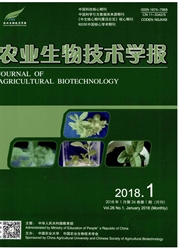

 中文摘要:
中文摘要:
脱水素(dehydrins,DHNs)是植物胚胎发育后期丰富蛋白(late embriogenesis abundant protein,LEA)中的一类,与低温、干旱以及盐胁迫等多种逆境反应相关。本研究采用c DNA末端快速扩增(rapidamplification of c DNA ends,RACE)技术从茶树(Camellia sinensis)中获得一种茶树脱水素基因Cs DHN(Gen Bank登录号:FJ436978),序列分析显示,该基因c DNA全长960 bp,编码201个氨基酸,推测编码蛋白质分子量约为21 k D,等电点为8.3,属于Y3SK2型脱水素。Cs DHN基因有2个外显子和1个内含子。生物信息学预测显示,该脱水素蛋白亲水性强、无信号肽和跨膜区,亚细胞定位于细胞质中。表达特性分析表明,Cs DHN在逆境及脱落酸(abscisic acid,ABA)诱导下可上调其转录水平,4℃低温处理下表达量可提高4.2倍,而脱水处理能提高93.4倍,高盐处理能提高17.8倍,Cs DHN对脱水、高盐胁迫的响应程度优于低温胁迫。Cs DHN在茶树各组织器官中都有表达,其中种子中表达量最高,为叶片的11.2倍。研究表明脱水素基因Cs DHN可能在茶树防御非生物逆境胁迫和参与茶树种子成熟脱水的活力保护过程起一定作用,为了解茶树抗逆分子机制提供了一定的理论基础。
 英文摘要:
英文摘要:
Dehydrins(DHNs), known as a group of late embryogenesis abundant proteins(LEA) in plants,are related to various environment stresses. In this study, Cs DHN(Gen Bank accession No. FJ436978), a full length c DNA of DHN in tea plant(Camellia sinensis) was amplified via rapid- amplification of c DNA ends(RACE) technology. It was shown that the full- length c DNA was 960 bp, encoding 201 amino acids by sequence analysis. The deduced molecular weight of DHN protein was 21 k D, together with isoelectric point8.3, which belonged to the Y3SK2 type of dehydrins. There were 2 exons and 1 intron in Cs DHN. The bioinformatics prediction revealed that Cs DHN located in the cytoplasm with no signal peptide or transmembrane domain. It was predicted to show strong hydrophilicity. The analysis of characteristic expression showed that Cs DHN was up- regulated in tea plant exposed to low temperature, dehydration,abscisic acid(ABA) treatment and salt stress. The expression of Cs DHN was increased not satisfactorily at 3and 6 h under low temperature stress at 4 ℃, while the expression level was increased greatly(two times higher than control, P〈0.05) at 12 h. And the highest expression, 4.2-fold than that of control, was found at18 h treatment, then decreased to its original level as control at 24 h. After the treatment of dehydration, the expression of Cs DHN was increased dramatically. The expression level was 7.5-fold than that of control at 3 h and continuously increased to the highest level at 18 h, with the expression level was 93.4-fold(P〈0.05) than that of control. After that, the expression was decreased to some extent, not maintained a high level. In accordance to ABA treatment, the expression amount was markedly increased at 3 h, and reached to its greatest amount at 6 h(4.3-fold than that of control, P〈0.05), then began to decline. A little bit higher than its original level was found at 18 h to 24 h treatment. When treated with the solution of 300 mmol/L Na Cl, the expression le
 同期刊论文项目
同期刊论文项目
 同项目期刊论文
同项目期刊论文
 期刊信息
期刊信息
